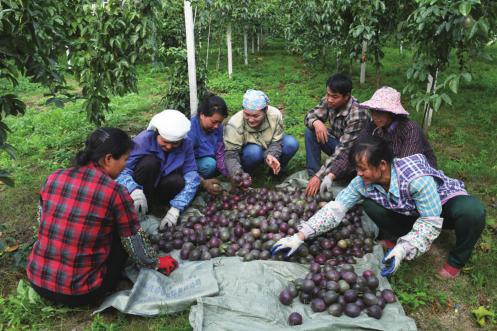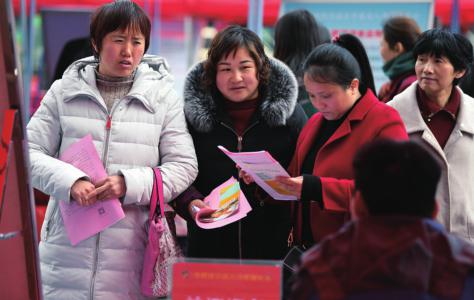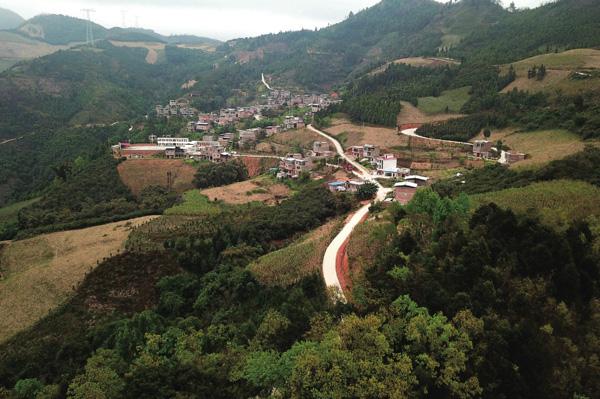Traditional Celebration
2018-04-08

Parents and children guess riddles during the Lantern Festival at a kindergarten in Jinhu County, east Chinas Jiangsu Province, on March 2. The Lantern Festival, the 15th day of the fi rst lunar month, fell on March 2 this year.
AI in Hospitals
An AI-general practitioner system developed by a Chinese tech fi rm has started its “internship” at a community hospital in east Chinas Anhui Province.
The “AI doctors assistant” can listen to doctors interactions with patients and automatically produce e-documents for patients medical notes.
Hu Jingyun, Director of the Shuanggang Community Health Service Center in Luyang District of Hefei, the provincial capital, said the“AI doctors assistant” could quickly review patient case histories and suggest prescriptions based on data from similar cases.
The system was developed by Shenzhen-listed iFLYTEK in partnership with Tsinghua University.
The companys medical robot passed Chinas national medical li- cense examination with a high score in 2017. It was the worlds fi rst robot to pass a national medical license examination.
The company said it had optimized the technology to serve as an“AI doctors assistant,” by equipping it with intelligent voice functions and self-learning abilities.
For now, the systems diagnoses and prescriptions still require the signature of a doctor for approval.
Ke Manxue, a health offi cial in Luyang District, said the region would use the “AI doctors assistant”to improve grassroots medical services, as it could ease the workload of general practitioners in outpatient services.
Poverty Relief
Southwest Chinas Tibet Autonomous Region lifted 530,000 people out of poverty during the fi ve-year period ending in 2017, the regions Poverty Relief Offi ce said on March 2.
At the end of 2017, about 330,000 Tibetan residents still lived below the regional poverty line, defi ned as a per-capita annual income of 2,300 yuan ($362) at 2010 prices, the offi ce said.
The poverty rate has been reduced to 12.4 percent from the 32.3 percent seen at the end of 2012, it said.
Many rural poor live in remote areas, where harsh weather and geological disasters can complicate relief efforts, said Lu Huadong, Deputy Director of the Poverty Relief Offi ce of Tibet.
Tibet, which has a population of around 3.2 million, has vowed to lift another 140,000 people out of poverty in 2018.
In 2017, the per-capita disposable income for urban and rural residents in the region reached 30,671 yuan ($4,840) and 10,330 yuan ($1,634), up 10.3 percent and 13.6 percent, respectively.
From 2016 to 2020, regional authorities plan to invest over 200 billion yuan ($31.5 billion) to eradicate poverty, with 90 percent of that investment going toward infrastructure and poverty-relief projects in the poorest areas.
China has set 2020 as the target year to fi nalize building a moderately prosperous society in all respects and to completely eradicate poverty.
Crimes Against Minors
More than 80,000 people were prosecuted from the beginning of 2016 to November 2017 on charges of child abuse, rape and traffi cking, according to Chinas top procuratorate.
During the same period, more than 58,000 were arrested on suspicion of these crimes, said Zheng Xinjian from the Supreme Peoples Procuratorate (SPP).
“Chinese procuratorates have always taken a zero-tolerance stance against crimes involving juvenile victims,” Zheng said.
Meanwhile, prosecutors nationwide have taken steps to protect the rights of adolescent suspects and show leniency to juveniles convicted of minor offenses in an effort to“educate and support” them.
Statistics from the SPP show that prosecutors exempted about 70,000 criminal suspects below the age of 18 from arrest from the beginning of 2013 to November 2017, 28.7 percent of all minor suspects.
During the same period, more than 27,000 minors, 8.9 percent of the total, were exempted from prosecution.
Ancient Site
On March 6, Chinese archaeologists announced the discovery of a rare and well-preserved township dating back some 2,000 years in southwest Chinas Sichuan Province.
Researchers with the Chengdu Cultural Relics and Archaeology Research Institute and Sichuan University found the remains of houses, kilns, wells, moats, and a sewage system as well as pottery during their excavation near Zhilu Village in the suburbs of Chengdu, the provincial capital, from June to October 2017.
One unearthed double-eared pot had characters engraved on it which serve as evidence that the area was a township-level site. The excavated area covers around 600 square meters. Before the excavation, the site was covered by farmland.
“It is the fi rst time a relic has been discovered with characters proving a township-level site from the Western and Eastern Han dynasties (202 B.C.-A.D. 220) in Chengdu,”said Yang Bo, the researcher in charge of the excavation.
Archaeologists also found part of the roof from a “luxury horsedrawn carriage” beside a fourmeter-wide road, suggesting that the township was once prosperous, according to Yang.
The site may have been neglected in the later years of the Eastern Han Dynasty and suffered minor damage after that, he added.
According to archaeologists, well-preserved sites from the Han Dynasty are rare nationwide. The site at Zhilu is of great signifi cance in the study of the life and production of residents as well as cultural development at that time, they said.
Organ Donation
According to the results of a survey released by the China Youth Daily on March 6, around 57.7 percent of respondents were willing to register for organ donation.
Of 2,013 participants, the survey found that 61.5 percent would not object to members of their immediate family donating their organs.
Around 74.9 percent said they had some knowledge of organ donation registration, while 19.2 percent said they had never heard about it.
As of December 24, 2017, a total of 373,536 people in China had registered for organ donation, according to data from the China Organ Donation Administrative Center.
A total of 57.3 percent of the respondents believed that low registration fi gures were due to traditional beliefs and psychological factors.
Interviewees suggested that China improve its laws and regulations regarding organ donation, expand registration channels and enhance publicity.
Of the respondents, 50.9 percent were born in the 1980s and 24 percent were born in the 1970s, the newspaper said.
Happy Harvest
Farmers sort freshly picked passion fruits in a rural community in Pumiao Township, Nanning, capital of south Chinas Guangxi Zhuang Autonomous Region, on March 5. With the harvest season fast approaching, local farmers are busy working in their orchards.
Pollution Census
On March 7, Beijing launched a survey of polluters as part of the drive for environmental protection, implementing a national plan to carry out a second census of pollution sources.
The survey, which targets the data from 2017, will help set up a database of key polluters, including their number and distribution in the industrial, agricultural, and residential sectors, as well as the discharge and treatment of pollutants.
Ten years after the countrys fi rst national census of pollution sources, China aims to fi nish a second survey this year before releasing the results in 2019.
The survey results will serve to strengthen the monitoring of polluters and improve environmental quality.
“A comprehensive and exact survey of pollution data will lay a foundation for winning the tough battle of pollution control,” said Yang Bin, Vice Mayor of Beijing.
Several other provinces and regions, such as Inner Mongolia and Jiangxi, have also started their own pollution censuses.
Opportunities for Women
Job seekers communicate with an employer at a job fair for women in Hefei, capital of east Chinas Anhui Province, on March 6. The job fair, held by the human resources sector of the Hefei Economic and Technological Development Area along with the local community, aims to offer more than 1,000 job opportunities from over 50 enterprises to the citys female workforce.
Energy Joint Venture
Two Chinese energy giants, China Shenhua Energy Co. and GD Power Development Co., have agreed to integrate their coal-fi red entities and assets to form a joint venture.
With a registered capital of 10 billion yuan ($1.58 billion), the joint venture will focus on power and heat generation and sales, according to a statement posted on the website of the State-Owned Assets Supervision and Administration Commission of the State Council (SASAC) on March 5.
GD Power Development Co. will take a 57.47-percent stake in the joint venture, while China Shenhua will hold the remaining 42.53 percent.
The joint venture will have a total installed power generation capacity of 66.29 million kilowatts in operation, with another 10.86 million kilowatts under construction, according to the statement.
The move marked a major step taken by the two companies to consolidate their businesses after their merger in August 2017 as SASAC works to restructure the countrys state-owned enterprises to improve effi ciency.
Rural Road Makeover
Long, winding roads pictured in Baise, Guangxi Zhuang Autonomous Region, on March 7.
The city has been committed to expanding infrastructure construction, helping to signifi cantly reduce poverty in rural areas.
More Bankruptcies
Chinese courts received 9,542 new cases involving corporate bankruptcy in 2017, an increase of 68.4 percent compared with 2016, the Supreme Peoples Court (SPC) said on March 6.
During the same period, 6,257 corporate bankruptcy cases were concluded by courts, up 73.7 percent year on year, the SPC said.
The top court requires nationwide courts to accept all bankruptcy petitions and issue written confi rmation of their receipt in an effort to facilitate market-oriented bankruptcy and boost high-quality economic growth, it said.
Bankruptcy reorganization has helped companies facing bankruptcy that still had value and hopes to reemerge, while bankruptcy liquidation has helped weed out“zombie enterprises,” or unprofi table fi rms burdened with debt, mismanagement or overcapacity, said Liu Guixiang, a senior offi cial with the SPC.
By the end of 2017, 97 courts had established liquidation and bankruptcy tribunals to facilitate the trial and settlement of bankruptcy cases. In early 2015, only fi ve courts in China had such tribunals.
Soaring Mobile Payments
Chinese banks saw a surge in mobile payments in 2017, offi cial data showed on March 5.
Banking institutions handled 203 trillion yuan ($32 trillion) in mobile payments, up 28.8 percent, according to the Peoples Bank of China (PBOC).
A total of 37.6 billion payments were made through mobile banking services, an increase of 46.1 percent, the PBOC said.
Chinas mobile payment sector has seen rapid development, driven by improved Internet infrastructure, increased use of mobile phones and innovations in fi nancial services.
In 2017, bank card transactions in China rose 2.7 percent to 762 trillion yuan ($120 trillion), while the number of bank cards in use went up 9.3 percent to 6.7 billion by the end of 2017, according to the PBOC.
Eliminating Overcapacity
North Chinas coal-rich Shanxi Province plans to cut 16 million tons of backward production capacity in state-owned coal mines in 2018.
The provincial state-owned assets supervision and administration commission said on March 7 that in 2017, provincially owned coal mines cut 12.75 million tons of coal production capacity by shutting down 10 mines with 14,000 workers.
The province issued its fi rst mining project license in 13 years earlier this month, saying it would be one of 19 new coal mine projects expected to showcase the provinces advanced coal-mining production.
Zhang Hongyong, deputy head of the commission, said it would seek to strengthen and restructure state-owned coal-mining equipment, coking, power-generating and other fi rms under its management, in a bid to break the dominance of stateowned coal mines.
With proven coal reserves of 270.9 billion tons, Shanxi produced more than 16.2 billion tons of coal from 1949 to 2014, accounting for one quarter of the total coal output across the country.
Over the past fi ve years, the province has eliminated 51 million tons of outdated coal production capacity and closed 56 mines.
In March, the provincial land and resources department launched a three-month campaign against illegal mining in a reinforced effort to curb the resurgence of mining activities in closed coal mines.
Zhou Jianchun, head of the department, said that it would check all coal mines during the campaign, registering both closed and operating coal mines in its electronic database. Based on this work, the department will then establish a blacklisting system to give timely warnings about irregularities in mining, he said.
Battery-Powered
A worker checks on the production of lithium batteries at a Ningde-based new energy company in Fujian Province on March 7.
In recent years, Ningde has been developing its lithium battery industry and in 2017 more than 40,000 workers were employed in the local industry.
Overseas Bond Issuer
The Industrial and Commercial Bank of China (ICBC) became the biggest bond issuer on NASDAQ Dubai after listing two new bonds on March 6, Dubai International Financial Center(DIFC) said.
The two fi xed income securities, worth $700 million each, bring the total value of the ICBC listings on NASDAQ Dubai to $3.56 billion in seven issuances, noted DIFC, a leading fi nancial hub in the Middle East.
The ICBC, the worlds largest bank by assets, set up its Dubai(DIFC) branch in 2008, making it the fi rst in the Middle East by a Chinese bank.
“The listings underline the strong fi nancial and economic relationship between Dubai and China, which is the largest trading partner of the United Arab Emirates,” DIFC said in a statement.
A day earlier, DIFC said Chinas big four banks managed to increase their assets value in the Middle East from $11 billion in 2014 to $33.4 billion in 2017.
All four Chinese banks—the ICBC, the China Construction Bank, the Agricultural Bank of China and the Bank of China—have their Middle East branches based in DIFC.
Stock Listings Reform Chinas security regulator is set to reform stock exchange listings in an effort to invigorate the countrys capital market and foster the new economy.
Jiang Yang, Vice Chairman of the China Securities Regulatory Commission (CSRC), said the listings mechanism reform is at the top of the regulators work agenda.
